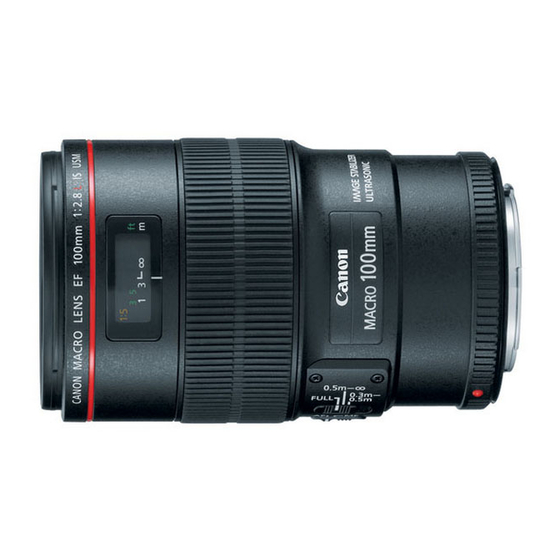
Table of Contents
Advertisement
Advertisement
Table of Contents

Summary of Contents for Canon EF 100mm f/2.8L Macro IS USM
- Page 1 EF100mm f/2.8L MACRO IS USM Instruction...
- Page 2 (ONE SHOT AF). 6. A truly round aperture hole results in a nicer background blur. 7. A Canon macro flash makes it easy to take close-up pictures with a flash. The inner focusing mechanism enables AF photography while the macro flash is attached.
-
Page 3: Handling Cautions
a Safety Precautions a Safety Precautions • Do not look at the sun or a bright light source through the lens or camera. Doing so could result in loss of vision. Looking at the sun directly through the lens is especially hazardous. •... - Page 4 Nomenclature Hood mount (→ 7) Filter mounting thread (→ 14, 15) Focusing ring (→ 5) Focus mode switch (→ 5) Image stabilizer switch (→ 10) For detailed information, reference page numbers are provided in parentheses (→ **). Distance scale (→ 6) Focusing distance range selection switch (→...
-
Page 5: Mounting And Detaching The Lens
The lens mount has a rubber ring for enhanced water- and dust-resistance. The rubber ring may cause slight abrasions around the camera's lens mount, but this will not cause any problems. If the rubber ring becomes worn, it is replaceable by a Canon Service Center at cost. ENG-4... -
Page 6: Setting The Focus Mode
2. Setting the Focus Mode To shoot in autofocus (AF) mode, set the focus mode switch to AF. To use only manual focusing (MF), set the focus mode switch to MF, and focus by turning the focusing ring. The focusing ring always works, regardless of the focus mode. -
Page 7: Infinity Compensation Mark
4. Infinity Compensation Mark Infinity compensation mark Distance index To compensate for shifting of the infinity focus point that results from changes in temperature. The infinity position at normal temperature is the point at which the vertical line of the L mark is aligned with the distance indicator on the distance scale. - Page 8 5. Hood The ET-73 hood can keep unwanted light out of the lens, and also protects the lens from rain, snow, and dust. To attach the hood, align the hood’s attachment position mark with the red dot on the front of the lens, then turn the hood as shown by the arrow until the lens' red dot is aligned with the hood's stop position mark.
-
Page 9: Picture Taking
6. Picture Taking Normal Photography The lens can be used as a medium-telephoto lens for normal photography such as portraits. Closeup Photography Close-up photos up to 1x (life-size) magnification are possible. The minimum focusing distance of 30 cm is the distance from the subject to the focal plane. -
Page 10: About Exposure
7. About Exposure Setting the Exposure When taking photographs using TTL metering, no exposure compensation is necessary to meter the light coming through the lens. With TTL metering, AE (autoexposure) is possible at all focusing distances. Just set the desired picture-taking mode, then check the shutter speed and aperture before taking the picture. -
Page 11: Image Stabilizer
8. Image Stabilizer You can use the image stabilizer in AF or MF mode. This function provides optimal image stabilization depending on shooting conditions (such as shooting still subjects and following shots). Set the STABILIZER switch to • If you are not going to use the image stabilizer function, set the switch to When you press the... - Page 12 Image Stabilizer • The shorter the subject distance from the camera, the lesser the Image Stabilizer effect will be. • The Image Stabilizer cannot compensate for a blurred shot caused by a subject that moved. • Set the STABILIZER switch to taking pictures using the Bulb setting (long exposures).
-
Page 13: Taking Hand-Held Close-Ups
9.Taking Hand-held Close-ups Close-up shots are more prone to be affected by camera shake than with normal shooting. The Image Stabilizer's corrective effect is therefore less during close-ups than during normal shooting even with the same degree of camera shake. The depth of field also becomes very shallow with close-ups, and moving forward or back even slightly will throw off the focus. -
Page 14: Using The Tripod Mount
10. Using the Tripod Mount Adjusting the Revolving Mount This lens can be used with the D (B) tripod mount ring, sold separately. You can loosen the orientation lock-knob on the tripod mount to allow it to rotate as needed to fit a particular camera model for switching between vertical and horizontal positions. -
Page 15: Extension Tubes
• Filters and the macro flash cannot be used on this lens at the same time. • If you need a polarizing filter, use the Canon Circular Polarizing Filter PL-C B (67mm). • To adjust the polarizing filter, first remove the lens hood. -
Page 16: Macro Flash
13. Macro Flash The Canon Macro Ring Lite MR-14EX or the Macro Twin Lite MT-24EX enables fully automatic macro flash photography up to 1x magnification in E-TTL autoflash mode. Install the Macro Lite Adapter 67 (sold separately) on the filter mounting thread on the front of the lens for macro flash photography. -
Page 17: Specifications
• The EF1.4X II/EF2X II extenders cannot be used with this lens. There are no compatible close-up lenses. • Aperture settings are specified on the camera. • All data listed is measured according to Canon standards. • Product specifications and appearance are subject to change without notice. - Page 18 CT1-7589-001 © CANON INC. 2009 2009.10...














